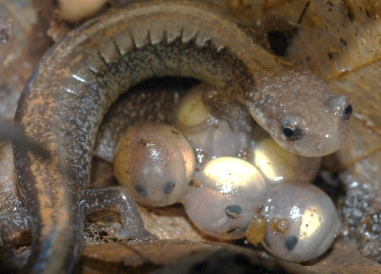Carl Anthony, PhD
Professor Emeritus - Biology

Phone Number
Location
Dolan Science Center W244
Employee Type
Faculty
Personal Websites

Expertise
Behavioral Ecology, Evolution, Herpetology
Dr. Anthony joined the Biology Department in 1996 where he has taught courses in ecology, evolution, and animal behavior. He earned M.S. in Biology from the University of Texas at Arlington in 1990 and his Ph.D. in Environmental and Evolutionary Biology from the University of Louisiana, Lafayette in 1995. Dr. Anthony has an active research lab where he and Dr. Cari Hickerson co-advise students in their studies of the Eastern Red-backed Salamander. This species is a model organism used in the study of animal communication, behavior, ecology, food-web dynamics, evolution, disease ecology, and conservation genetics. Dr. Anthony is currently teaching Advanced Ecology and Laboratory most fall semesters.
Research Interests
My research interests include kin selection, food web dynamics, and the roles of aggressive behavior and territoriality in competitive exclusion. I use predatory invertebrates, amphibians, and reptiles as model systems. Most recently, my students and I have been exploring the role of biofluorescence in animal communication. We conduct laboratory and field studies to address these topics.
Teaching Interests
Dr. Anthony has taught courses in the introductory biology sequence as well as upper division and graduate courses in Animal Behavior, Ecology, and Evolution. As an Emeritus Professor, he continues to teach Advanced Ecology and the associated laboratory, a course that uses experiential learning techniques including a semester-long independent/group project.
Recent Courses
-
BL 4440/4445 - Advanced Ecology and Laboratory
Recent Publications
- Anthony, C.D., C.M. Hickerson, T. M. Evers, K. L. Garner, and R.D. Mayer. 2023. Sexually dimorphic biofluorescence of the postcloacal gland in the terrestrial salamander, Plethodon cinereus. Journal of Herpetology 57:262-267.
- Kuchta, S.R., M.M. Hantak, B.P. Waldron, C.D. Anthony, C.M. Hickerson, and R.M. Lehtinen. 2022. Hybridization the woodland salamanders Plethodon cinereus and P. electromorphus is not widespread: Revisiting Lehtinen et al. Ichthyology and Herpetology, 110:430-438.
- Venesky, M.D., J. DeMarchi, C.M. Hickerson, and C.D. Anthony. 2022. Does the thermal mismatch hypothesis predict disease outcomes in different morphs of a terrestrial salamander? Journal of Experimental Zoology Part A: Ecological and Integrative Physiology, 1–10.
- Waldron, B.P., M.C. Ganzfried, C.M. Hickerson, and C.D. Anthony. 2022. Repeatability of foraging behavior following a simulated predation attempt depends on color morph, sex, and foraging metric in red-backed salamanders (Plethodon cinereus). Published online. Ethology, Ecology, and Evolution 34:471-484.
- Hantak, M.M., K.A. Brooks, C.M. Hickerson, C.D. Anthony, and S.R. Kuchta. 2020. A spatiotemporal assessment of dietary partitioning between color morphs of a terrestrial salamander. Copeia 108:727-736.
- Venesky, M, J. DeMarchi, R. Marbach, K. Pariyar, C.M. Hickerson, and C.D Anthony. 2020. Female salamanders experience higher parasitism compared to males: a cost of female reproduction? Journal of Herpetology 54:293-298.
Degrees, Awards and Recognition
- B.A. in Biology, North Central College
- M.S. in Biology, University of Texas at Arlington
- Ph.D. in Environmental and Evolutionary Biology, University of Louisiana at Lafayette
- Lucrezia Culicchia Award for Teaching Excellence (2014)

The Eastern Red-backed Salamander
Dr. Anthony uses the Eastern Red-backed Salamander as a model species to explore questions in diverse areas of the biological sciences.